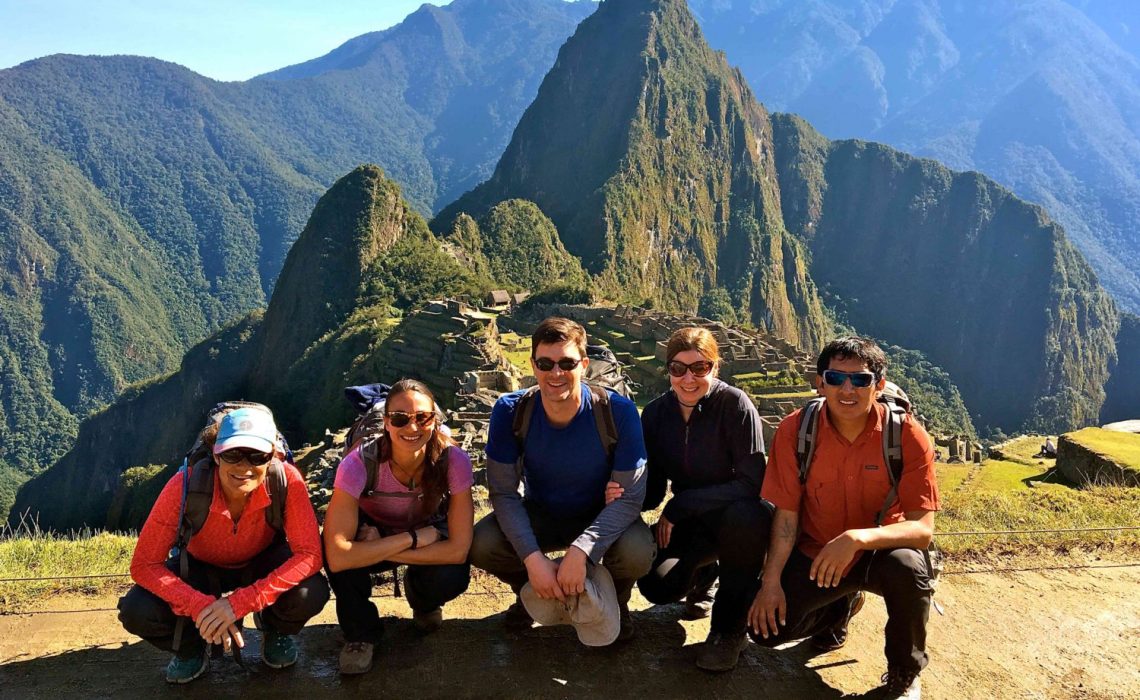
You might also like:
Of all the Peru landmarks, Machu Picchu (which in the Quechua native language, means “Old Peak” or “Old Mountain.”) is the one categorised as both one of the best known and also most mysterious of the ancient Inca sites. Call it cliche to label it the jewel of Peru’s crown or it’s most famous contribution to the 7th wonders of the world, but Machu Picchu has remained in the limelight since it’s discovery by Hiram Bingham in 1911. It stands at 2,400 meters above sea level and it’s precise stone construction is spread along a narrow and uneven mountain vista, tucked up against a 400m sheer cliff, overlooking the Urubamba Valley and River. The whole city was hidden (and thus saved) from marauding conquistadores for centuries and its high remote location makes if feel like it is floating on a sheet of mist.
Local guides will tell of legends withed down from Inca ancestors, archaeologists will give you another perspective all adding to the sites enigmatic status, but it’s actually quite hard to put your finger on the reasons why this citadel in the clouds is just so fascinating.
Many of the discoveries in and around Machu Picchu have led to more questions than answers around it’s true purpose. The more discoveries made it seems, the wider the variety of possibilities.
Rather than give you a list of dates, numbers and scientific facts, this page is going to offer you a treat, so you can wow your guides and make them think you’ve been on a crash course of anthropology and/or Incan philosophy!
I probably don’t need to tell you that Machu Picchu’s walls, caves and buildings are widely adorned with intricate carvings in the citadel, boasting carefully selected cave entrances, strange altars, 600 impressively engineered terraces, a 1km long aqueduct and exquisitely engineered buildings. Quizzical llama lawnmowers help to keep the grass around the buildings all beautifully manicured, showing off their best features. It is indeed a sensory feast for 21st century eyes staring firsthand at structures built by Incan hands more than a thousand years ago!
Did you also know that the positioning of the buildings are no accident. Inca people were master astrologers, the milky way had particular significance, and they arranged structures within the citadel to align with the cosmos or rising of the sun at specific times of year?
Standing amongst these features, everyone marvels at the masterful engineering the ancient Incan builders managed to achieve way back in the mid 14th century. You may find yourself getting lost in stories told by local legends if you walk through the various buildings with a local guide (like our Cynthia Valledares). When you also understand the significance of the structures around you from a spiritual and ritualistic point of view – it is not at all difficult for ones mind to be blown!
Machu Picchu Architecture
The technique used to build the structure is called called “ashlar”, this means that stones that are precisely cut to fit together without any mortar. This method is so precise that not even a credit card can slide between stones. Peru has experienced hundreds of years of seismic activity, yet the stones the Inca’s crafted stand strong, mostly undamaged by natures powerful forces.
Some of the most interesting architectural features of Machu Picchu are all closely huddled together over it’s total area of 32,592 hectares, an assortment of structures, each with an archaeological and spiritual back story that would make even Indiana Jones proud!
Sacred Rock
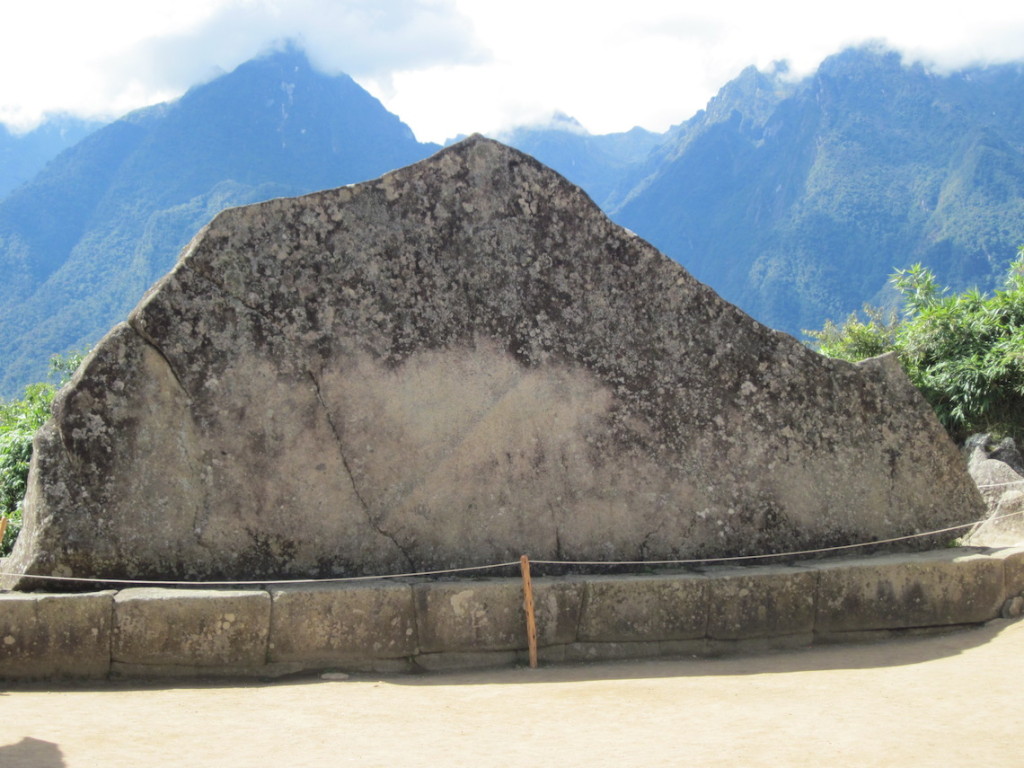
Looking out over the central plaza to the far end of Machu Picchu , we find the Sacred Rock, something you will notice in almost every Inca village. The Inca practiced placing a sacred stone in close proximity to the building site and this was dedicated to the site itself, which adds to the intrigue of the site; what did this mean to these people, and what daily practices took place right here where you stand, some say they can still feel the energy of these people and the land they revered so much.The Sacred Stone of Machu Picchu was carefully placed at the base of Huayna Picchu (or little peak), a place from which it’s possible to ascend right up to the summit, for a magnificent view down the valley. After your hour-long hike to the top of the peak, you can choose to stop off on the way back down at the Gatekeeper’s shack for a signed memoir, verifying you have conquered the steep climb up Huayna Picchu. The rock, resembling the shape of the top of the mountains behind it is a shrine where the Incas carried out special rituals and pachamamas (offerings to the earth).
The Sacred Rock is a powerful symbol in Machu Picchu, and is recognised as being a spiritual area for meditation and absorbing positive energies.
Many visitors like to include Temple of The Moon cave, another enigmatic structure situated approximately 1280 feet or 390 m below the summit of Huayna Picchu facing North. This is less than an hours walk from Sacred Rock, and will reward you with not only grand Inca structures to marvel over, but also spectacular views down the valley.
Central Plaza
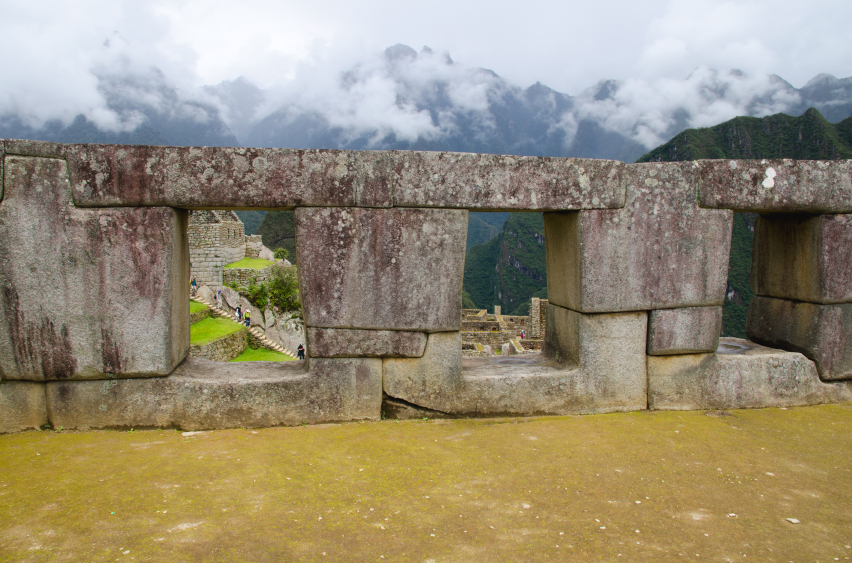
The Central Plaza of Machu Picchu is laid out with rows of many roofless stone structures embedded among steep terraces, facing outward for a grand view of Huayna Picchu. The lush green grass colour in the middle of the plaza can be likened to an island sitting amongst the rest of the Inca stone buildings that make up Machu Picchu. It’s an enticing and inviting spot amongst the buildings for Llamas and other grazing animals to frequent for a tasty meal. The Central Plaza’s grassy field also provides separation from the Sacred Plaza and Intiwatana to the residential areas on the farther side of the complex.
One of the buildings bordering the plaza is the Temple of the Three Windows. From this standpoint we look out to see a pretty view out on to the green central field, if we carry on from here, a flight of stairs at the back of the Sacred Plaza takes us back down to the Central Plaza.
At the very lowest end of the Central Plaza we find what is known as the Prison Group, this is essentially a network of cells, passageways, and niches extending both underground and up to the plateau above. Right in the center of this group of structures, we find the Temple of the Condor, some visitors and locals call this the main attraction because of its attention seeking condor carved in stone right above a rock pile. Behind this striking carved condor head, is a doorway leading to a tiny underground cell.
Temple of the Condor
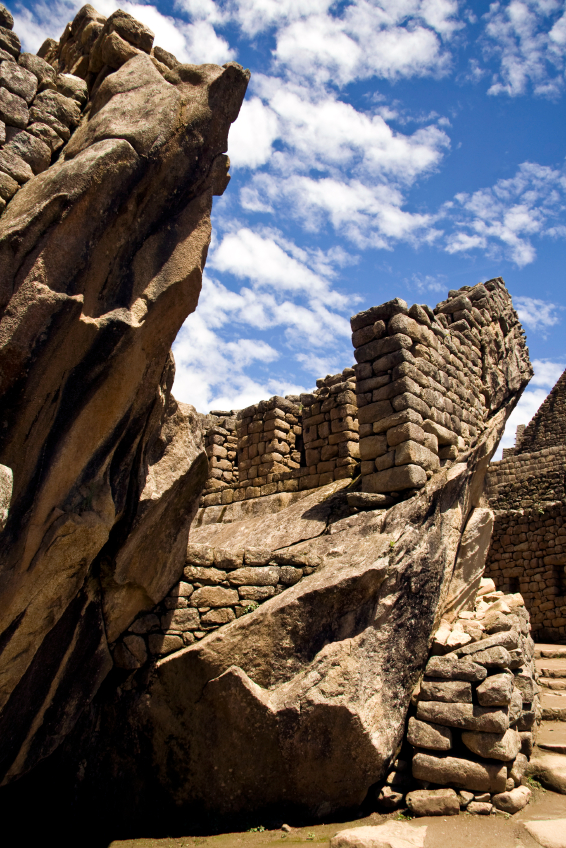
The Temple of the Condor in Machu Picchu has to be one of the highlights (although you will find it difficult to choose one) of your exploration of these Inca ruins. It is an exquisite example of Inca stonemasonry. The Inca took a natural rock formation shaped by the elements millions of years ago, and skillfully shaped it into the outspread wings of a condor in flight. The Condor represented spirit and higher levels of consciousness, so the Inca considered the Condor to be of elevated importance in the animal, and spirit kingdom.
On the floor of the Condor temple you can see a rock carved in the shape of the condor’s head and neck feathers, this section of the rock makes up the figure of a three-dimensional bird. Historians speculate that the Inca used the head of the condor here as a sacrificial altar. Underneath this is a small cave that used to contain a mummy, the hierarchal importance of which perplexed archaeologists like many other mummified remains found in this area. Behind the temple, is situated a prison complex. The prison comprised of many human-sized niches and an underground maze of dark dingy dungeons. The close proximation of the alleged sacrificial temple and the prison structures conjures up visions of how the Inca may have used them for sacrifice or other rituals. Similar Inca prison sites, record events outlining the handling of an accused citizen… word has it that the prisoners would be shackled into these niches for up to 3 days to await their fate. The jury could nominate their death for such simple sins as laziness, lust, or more in line with Victorian punishments, theft.
Funerary Rock Hut
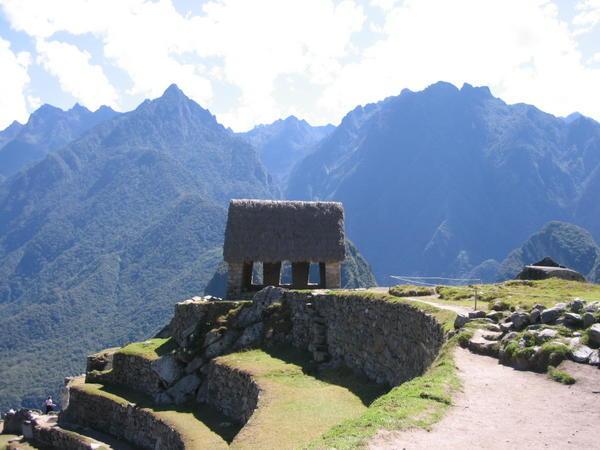
If you are a photographic enthusiast, you will want to take a small hike to Machu Picchu’s Funerary Rock Hut. It’s believed this location was the place where Inca nobility were mummified, and like many places chosen for overseers to rest, the vantage point from the hut offers a dramatic view over the whole complex.
Every day herds of Alpacas and Llamas arrive via the terraces near the Funerary Rock Hut to graze leisurely on the grass. These furry manicurists keep the lawns short, neat and tidy for our benefit whilst filling their stomachs with rich green grass. From this position we look out towards the start of the Inca Trail, in contrast to many of the skinny mountainous trails in the region, it is easy to see because the Inca Trail is a well developed wider road that connects the Cusco region directly with Machu Picchu.
The hike up the long sturdy stairs that lead to the Funerary Rock Hut will give your muscles a good workout, but the rewards at the end of this short but relatively steep hike are worth every drop of sweat. The views from this viewpoint will stay in your memory along with many snapshots of your unforgettable trip to Machu Picchu.
From this point we take a detour back down the stairs to arrive at the Royal Tomb.
Royal Tomb
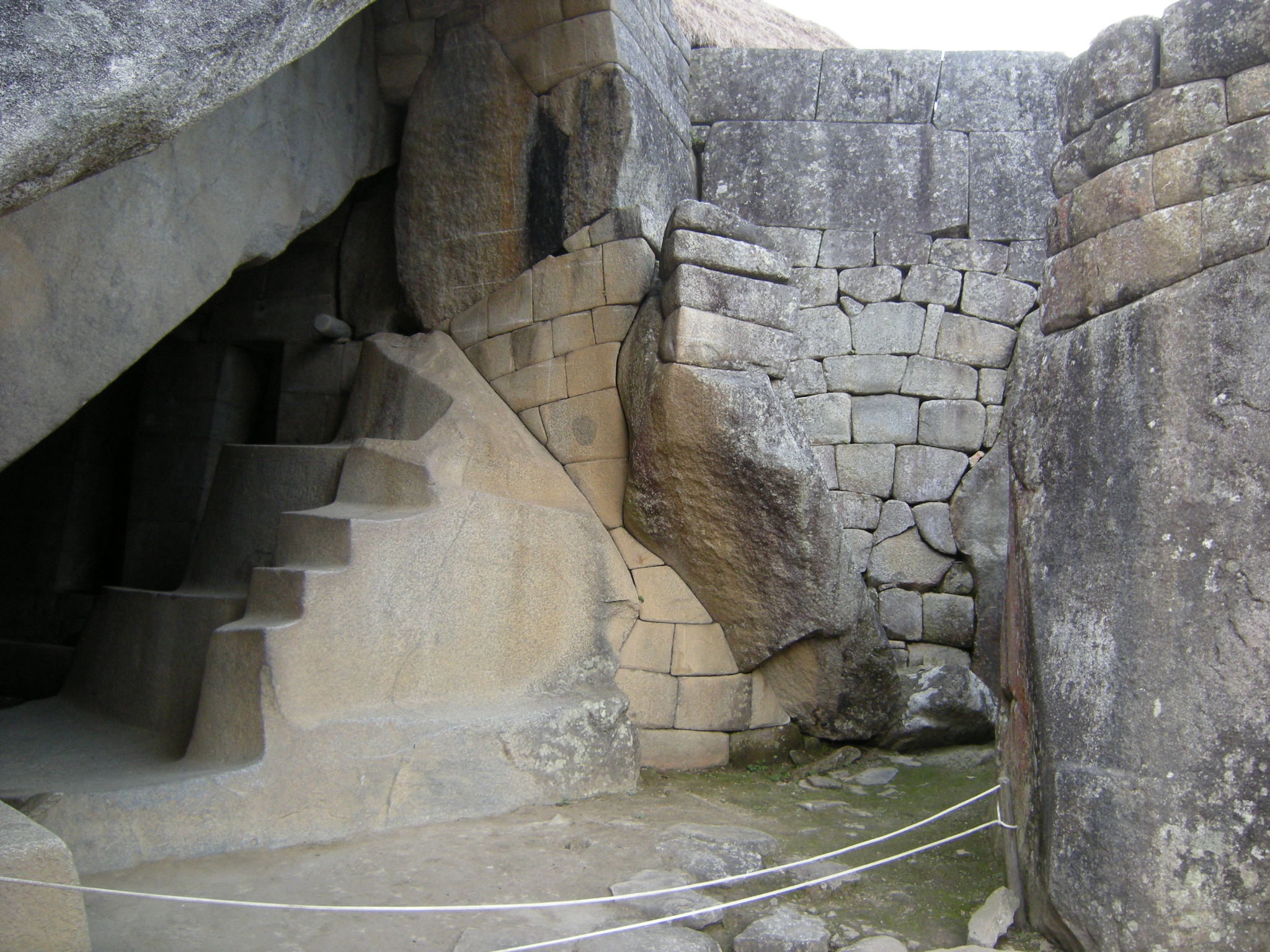
Walking down and to the left descending a long set of stairs, we approach the Royal Tomb. This cave-esque area of Machu Picchu is decorated with ceremonial niches and adjacent to the Temple of the Sun is a carefully carved Inca cross. The cross design resembles steps, and represents the three levels of existence in the Inca world. The first step, symbolised by the snake, is representative of the underworld or of death. The second step represents the present, or human life, symbolised by the jaguar. The highest step represents the celestial or spiritual plane of the gods, and is symbolised by the condor.
This revered site has been the focus of numerous mummy excavations. Over 100 skeletal remains have been discovered here, 80% of which were women. For this and several other factual reasons, historians surmised that the area was inhabited primarily by Inca high priests and an elite selection of chosen women.
Immediately to the left of the royal tomb lies a series of 16 ceremonial baths, cleverly linked together via a skilfully engineered viaduct. At the top of this system we find the watershed hut, which passes beside the rock quarry emerging at the Sacred Plaza.
Intiwatana
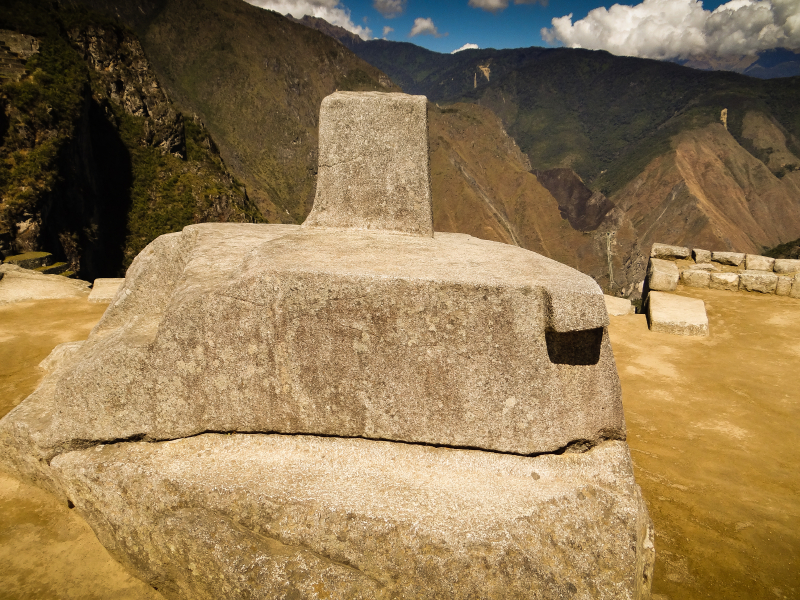
The Intiwatana at Machu Picchu, is referred to by Inca and modern people as the “hitching post of the sun”. One of Machu Picchu’s primary functions was that of astronomical observatory. It is a carved rock pillar with construction planned to orient towards the four cardinal points. As accomplished astronomers the Inca used the angles of the pillar to accurately predict the solstices. The sun was an integral part of the Inca way of life and greatly influenced agriculture which supported the life of the whole community. The Inca considered the Sun the supreme natural god and during the winter solstice on June 21, it is said that the high priest would rope a golden disc to the Intiwatana, to symbolically catch the sun, returning it back to earth, thus ensuring another bountiful season of crops.
Sadly the Intiwatana is the only structure of its kind left standing by the Spanish conquerors, who went on a aggressive campaign to wipe out all structural references to Inca religion. Many visitors report that Machu Picchu feels like one of Earth’s magnetic focal points, it emanates a mystical quality and carries an inherent spiritual or metaphysical power.
When you’re sitting on the edge of heaven, perched high above the valley at the Sacred Plaza looking down at the Urubamba River below, it’s hard to deny the etherial sense this place is embued with. Turn around behind you, and absorb the genius of the ancient builders who created these stone plaza and temple structures, framed magnificently in the background by the spectacular mountain peaks of Machu Picchu and Huayna Picchu to the left and right. How could you not be moved and humbled by this experience?
Huayna Picchu
The big little mountain that everyone forgets. Huayna Picchu is like a jewel in the crown of Machu Picchu. Standing at 2,720 metres (8,930 feet), it towers above and behind the citadel of Machu Picchu. Only 400 people are allowed daily to climb Huayna Picchu in 2 groups – first departing at 7.00AM second at 10.00Am. The steep (both hands and feet needed) climb winds up the side of the rock faces and through a tunnel. It takes about 1.5-2 hours up and about 45 minutes to 1 hour down. For many people climbing Huayna Picchu is one of the highlights when visiting Machu Picchu. The view from the top highlights how the structures and terraces below are built on seemingly impossible places like they are almost glued to the mountain side. You are in for a breathtakingly beautiful panorama of the site of Machu Picchu below, but also the snowcapped mountains and grand valleys beyond.
Machu Picchu is divided in two parts
Hanan and Urin according with the Inca tradition. This essentially means upper and lower, or heaven and earth. The upper realm = included the sky, the sun, the moon, the stars, the planets, and constellations (milky way in particular) and was called hanan pacha (in Quechua). The hanan pacha was inhabited Inti, the masculine sun god, and Mama Killa, the feminine moon goddess. The lower realm is where earth spirits reside, or the people who inhabit the earthly realms.
Popular Trails Leading To Machu Picchu
Ancient Inca rulers forged trails and communication systems through this region over 18,600 miles long, paving mountain tracks, building runners and swing bridges from straw ropes. Most of these structure still exist today, and it’s quite astounding to think that the well worn steps you are walking on when traversing the Inca or Lares trails were hand constructed by Inca stonemasons so very long ago.
The most popular trails leading to Machu Picchu are the Lares Trail and the Inca Trail. There is also the Salkantay trek, but the two most raved about journeys by far are the Lares and Inca trail. The Lares takes you through many more villages, without the same level of foot traffic you may encounter on the Inca Trail. You can also opt for cycle and kayak options, where you can visit a small village on Lake Titicaca’s reed islands and hang with the locals. Experiences like these are magical, they add a few more days to your adventure, but you’ll leave with a whole new sense of the meaning of immersion in another uniquely Peruvian culture. Check out this comparison between the Inca Trail vs. Lares Trails or take a look at our Jaguar trip which gives you the option of visiting these places and many more.
Inca Trail Hike to Machu Picchu
A trip to Machu Picchu along the Inca trail is the epitome of a spiritual and wondrous experience to one of the worlds most fascinating ancient wonders of the world. An unforgettable experience is not something you have to ‘try’ to achieve when visiting Machu Picchu – you’ll be taken on a journey of curiosity and wonder in all directions.
Facebook Review:
Noel Carroll reviewed Active Adventures – 5 star – 29 July ·
Jaguar trip to Peru. Great guides, accommodations, activities, food. Absolutely the best adventure I have had, and I have been blessed with quite a few. Would definitely consider another one. Hiking the Inca trail on this trip was the hardest and most rewarding thing I have done.
Other pages that may be of interest:
Best Time To Trek Machu Picchu | Machu Picchu Tours |4 Day Machu Picchu Trek
Source: activeadventures.com
